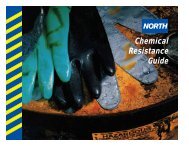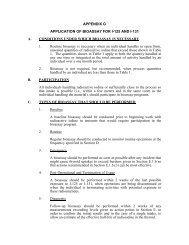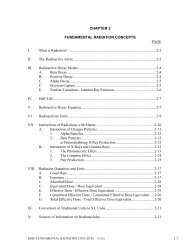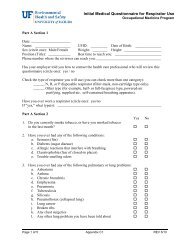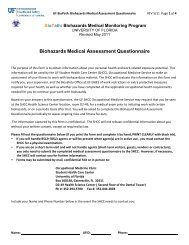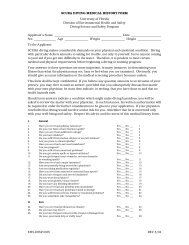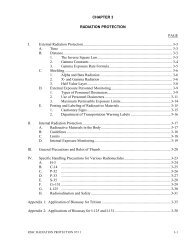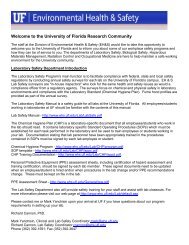S+/L- assay: Vector stocks are amplified by passaging in permissive cell lines (e.g. Mus dunni;CRL-2017). Culture supernatant is used to transduce naïve cell line (PG4; CRL-2032) whichexpresses murine sarcoma virus genome (S+) but not MLV (L-). Foci <strong>of</strong> transformed cellsindicate presence <strong>of</strong> RCR in the supernatant. Cell lines and positive control virus (4070A VR-1450) are available from the ATCC.Marker Rescue assay: Permissive cell line used in amplification process contains a retroviralvector with marker gene e.g. for drug resistance. A positive RCR is indicated by the development<strong>of</strong> resistant clones.Advantages <strong>of</strong> using Gammaretroviral Vectors: Can be used in actively dividing cells Used in clinical trials-though 4 cases <strong>of</strong> leukemia were reportedDisadvantages <strong>of</strong> using Gammaretroviral Vectors: Can only transduce actively dividing cells Can stably integrate into host genome Insertional mutagenesis is a point <strong>of</strong> concern. RCR can occur by combination between vector and either the viral genes, or endogenous viralsequences especially from murine-based cell lines.References: Lakshmi Sastry and Kenneth Cornetta. (2009). Detection <strong>of</strong> Replication Competent Retrovirusand Lentivirus. Methods in Molecular Biology, Methods and Protocols, 506, 243-263 Tobias Maetzig, Melanie Galla, Christopher Baum and axel Schambach (2011). GammaretroviralVectors: Biology, Technology and Application. Viruses3, 677-713 L.-J. Chang and E.E. Gay. (2001). The Molecular Genetics <strong>of</strong> Lentiviral Vectors-Current andFuture Perspectives. Current Gene Therapy 1, 237-251 Keith Bupp and Monica Roth. (2000). Strategies and mechanisms for retrovirus retargeting. InViral Vectors: Basic Science and Gene Therapy. Edited by A. Cid-Arregui and A. Garcia-CarrancàLentivirus:Lentiviruses are complex retroviruses that include Human Immunodeficiency virus (HIV-1), SimianImmunodeficiency virus (SIV), and Feline Immunodeficiency virus (FIV-1). HIV-1 -derived vectors areextensively used in research as viral vectors. The vectors are particularly useful due to their ability toinfect both the dividing and non-dividing cells. Aside from retroviral genes gag, pol, and env, lentivirusescontain other regulatory and accessory genes e.g. rev, tat, nef, vpr, vpu and vif that have a role in viralreplication and infection. Lentiviral vectors (LVV) are typically made by transient transfection <strong>of</strong> 3-4plasmids into HEK293 or 293T cell line. The vector has evolved over time to address the safetyconcerns. The first generation LVV was manufactured using all HIV-1 genes except the envelope gene.In the second generation packaging system, made with 3 plasmids, all except 4 HIV-1 genes viz. gag,pol, rev and tat are eliminated. In the third generation vector which utilizes 4 plasmids, tat is removed,gag/pol and rev are placed on separate expression cassettes and there is a chimeric 5’LTR (long terminalrepeat).Other safety features <strong>of</strong> the vector include a pseudotyped envelope (e.g. VSV-G), which enhances thevector tropism and 3’LTR deletions which eliminates the viral LTR enhancer/ promoter activity making ittranscriptionally inactive (SIN or self-inactivating LVV).Replication Competent Lentivirus (RCL) testing. Even if the vector is non-replicating, there is a theoreticalpossibility <strong>of</strong> homologous recombination event between different vector components rendering itreplication competent (RCL). Several assays are used to test the vector stocks for presence <strong>of</strong> RCL,notably a cell culture-based assay in which RCL in the vector stock, if present is amplified by culturingonto a permissive cell line (various lines are available). Supernatant containing viral particles is collected27
and inoculated on to an indicator cell line. Cells/supernatants are analyzed for viral markers usingvarious tests e.g.: p24 gag antigen ELISA. Decrease in protein expression with successive passages indicatesabsence <strong>of</strong> RCL. A kit is available (Perkin Elmer) to detect protein expression. Positive controlstandard (purified p24 gag protein) is included in the kit. The test is easy, rapid and reproduciblebut the kits are expensive. Product-enhanced reverse transcriptase (PERT) assay to detect reverse transcriptase associatedwith the virus. This is reported to be a very sensitive assay. psi-gag and VSV-G envelope PCR assays using genomic DNA extracted from indicator cell line.Plasmid DNA containing the respective sequences is used as positive control. Marker Rescue assay: GFP expressing cell line (e.g. HeLa4G) is transduced with LVV vectorstock. The cells are passaged a few times after which the media is inoculated onto a GFPnegativecell line (e.g. 293T). GFP expression is studied by FACS/ immun<strong>of</strong>luorescence.Positive controls are required and must be included with the tests. At least 2 consecutive assays onindependently generated LVV preparations are usually recommended. Use <strong>of</strong> at least two separateassays that detect different viral genes or functions is advised.Risk Assessment: BSL-2+ is recommended for in vitro use <strong>of</strong> LVV; + emphasizes appropriate personal protectiveequipment, safety sharps and substitution <strong>of</strong> plastic for glass. Caution is always advised to takemeasures to avoid self-inoculation with LVV to prevent insertional dysregulation <strong>of</strong> cellular genesthat can occur at a frequent rate ABSL-2 is recommended for animal injections and housing for use <strong>of</strong> second generation or lowerLVV where RCL data is not available, lowered to ABSL-1+ with instructions for using safe sharps,safety needles, protection <strong>of</strong> mucous membranes, skin, eyes, and conducting work in certifiedbiosafety cabinets to minimize the risk to researchers in case <strong>of</strong> accidental exposure to thevector, with ABSL-1 for subsequent housing if the vector stock is tested for RCL and results <strong>of</strong> 3consecutive tests are reviewed by the Institutional Biosafety Committee (IBC). All LVV made using 3 rd and 4 th generation systems are considered replication incompetent andRCL testing is not required. These are generally recommended at ABSL1+ for animal handlingand ABSL-1 for housing ABSL-1+/ABSL-1 is also recommended if the vector backbone has tested negative for RCL inthe past (by UF PI) or if the documentation <strong>of</strong> RCL testing for vectors obtained from PIs outside <strong>of</strong>UF, or from a commercial source is available and is reviewed by the IBC. Based on the risk assessment, biosafety levels maybe higher if LVV is cloned withoncogenic/toxic inserts. Large scale LVV preparation (>10L) is recommended at BSL-3 containment levelAdvantages <strong>of</strong> using Lentiviral Vectors: Can be used in non-dividing cells Used in clinical trialsDisadvantages <strong>of</strong> using Lentiviral Vectors: Can stably integrate into host genome Insertional mutagenesis is a point <strong>of</strong> concern. RCL can occur by combination between vector and the viral genesReferences: Stéphanie Durand and Andrea Cimarelli (2011). The inside out <strong>of</strong> Lentiviral vectors. Viruses 3,132-159 James N. Warnock, Claire Daigre, & Mohamed Al-Rubeai. Introduction to viral vectors. Methodsin Molecular Biology (2011) 737: 1-25.28
- Page 1: UNIVERSITYBiosafetyManual2014OFFLOR
- Page 5 and 6: Hurricane Watch ...................
- Page 7 and 8: Authority & ResponsibilitiesBy auth
- Page 9 and 10: All projects involving recombinant
- Page 11 and 12: Tools for Risk AssessmentBoth the N
- Page 13 and 14: The risk assessment will also deter
- Page 15 and 16: assessments and tests/immunizations
- Page 17 and 18: protection of workers and the envir
- Page 20 and 21: Have limited toxicological data app
- Page 23 and 24: Integration of rAAV genomic sequenc
- Page 26 and 27: from fowlpox virus) are most widely
- Page 30 and 31: Kenneth Cornetta, Jing Yao, Aparna
- Page 32 and 33: material. The catalyst for increase
- Page 34: Engineering ControlsThese devices a
- Page 38: PPE to protect eyes and face is use
- Page 41 and 42: DisinfectantsDisinfectants are chem
- Page 43 and 44: Formaldehyde Gas (from heating para
- Page 45 and 46: Call Building Services, 294-5500, t
- Page 47 and 48: Autoclave use log must be available
- Page 49 and 50: After the disaster has occurred, de
- Page 51 and 52: Workplace ViolenceAll threats and o
- Page 53 and 54: Account for coworkersWait for any i
- Page 55 and 56: 4. The physician may wish to consul
- Page 57 and 58: Spill Outside the LaboratorySafe tr
- Page 59 and 60: An emergency room should only be us
- Page 61 and 62: staff notifies the PI of any person
- Page 63 and 64: Departments: Assist EH&S in identif
- Page 65 and 66: Investigational New Drug (IND) Vacc
- Page 67 and 68: Transport of Biological Materials o
- Page 69 and 70: All human, animal, or plant pathoge
- Page 71 and 72: Special IssuesHIV Research Laborato
- Page 73 and 74: Symptoms suggestive of B virus infe
- Page 75 and 76: tuberculosis are a potential source
- Page 77 and 78: Table 2. Summary of Recommended Bio
- Page 80 and 81:
Table 4: Select Agents and Toxins79
- Page 82 and 83:
Table 6: Summary of NIH Guidelines;
- Page 84 and 85:
Section Subsection Research Applica
- Page 86 and 87:
App C-IVKluyveromyces Host-Vector S
- Page 88 and 89:
Table 8: Summary of Biosafety of Vi
- Page 90 and 91:
ResourcesBiosafety Resources: http:
- Page 92 and 93:
OCCMEDOPIMOSHAPAPRPIPPEPPQPSDSRACrD
- Page 94 and 95:
ParenteralPathogenPathogenicityPers
- Page 96 and 97:
Plant, Plant Pests, Noxious Weeds,a
- Page 98 and 99:
Select Agent RegulationsAnimal, Ani
- Page 100 and 101:
Transportation RegulationsTransport




